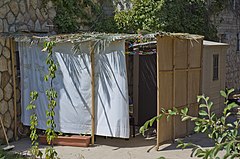| Sukkot | |
|---|---|
 A sukkah (plural: sukkot) in a kibbutz in Gush Etzion | |
| Official name | Hebrew: סוכות or סֻכּוֹת ("Booths, Tabernacles") |
| Observed by | |
| Type | Jewish, Samaritan |
| Significance | One of the three pilgrimage festivals shalosh regalim |
| Observances | Dwelling and eating festive meals in a sukkah; holding and carrying the four species; doing hakafot and praising God with hallel prayers in synagogues |
| Begins | 15th day of Tishrei |
| Ends | 21st day of Tishrei |
| Date | 15 Tishrei, 16 Tishrei, 17 Tishrei, 18 Tishrei, 19 Tishrei, 20 Tishrei, 21 Tishrei |
| 2023 date | Sunset, 29 September – nightfall, 6 October (7 October outside of Israel) |
| 2024 date | Sunset, 16 October – nightfall, 23 October (24 October outside of Israel)[1] |
| 2025 date | Sunset, 6 October – nightfall, 13 October (14 October outside of Israel) |
| 2026 date | Sunset, 25 September – nightfall, 2 October (3 October outside of Israel) |
| Related to | Shemini Atzeret, Simchat Torah |

Sukkot,[a] also known as the Feast of Tabernacles or Feast of Booths, is a Torah-commanded holiday celebrated for seven days, beginning on the 15th day of the month of Tishrei. It is one of the Three Pilgrimage Festivals on which Israelites were commanded to make a pilgrimage to the Temple in Jerusalem. Biblically an autumn harvest festival and a commemoration of the Exodus from Egypt, Sukkot’s modern observance is characterized by festive meals in a sukkah, a temporary wood-covered hut.
The names used in the Torah are "Festival of Ingathering" (or "Harvest Festival", Hebrew: חַג הָאָסִיף, romanized: ḥag hāʾāsif)[2] and "Festival of Booths" (Hebrew: חג הסכות, romanized: Ḥag hasSukkōṯ).[3][2] This corresponds to the double significance of Sukkot. The one mentioned in the Book of Exodus is agricultural in nature—"Festival of Ingathering at the year's end" (Exodus 34:22)—and marks the end of the harvest time and thus of the agricultural year in the Land of Israel. The more elaborate religious significance from the Book of Leviticus is that of commemorating the Exodus and the dependence of the Israelites on the will of God (Leviticus 23:42–43).
As an extension of its harvest festival community roots, the idea of welcoming all guests and extending hospitality is intrinsic to the celebration. Actual and symbolic "guests" (Aramaic: ushpizin) are invited to participate by visiting the sukkah. Specifically, seven "forefathers" of the Jewish people are to be welcomed during the seven days of the festival, in this order: Day 1: Abraham; Day 2: Isaac; Day 3: Jacob; Day 4: Moses; Day 5: Aaron; Day 6: Joseph; Day 7: David.[4]
The holiday lasts seven days. The first day (and second day in the diaspora) is a Shabbat-like holiday when work is forbidden. This is followed by intermediate days called Chol HaMoed, during which certain work is permitted. The festival is closed with another Shabbat-like holiday called Shemini Atzeret (one day in the Land of Israel, two days in the diaspora, where the second day is called Simchat Torah).
The Hebrew word sukkoṯ is the plural of sukkah ('booth' or 'tabernacle') which is a walled structure covered with s'chach (plant material, such as overgrowth or palm leaves). A sukkah is the name of the temporary dwelling in which farmers would live during harvesting, reinforcing agricultural significance of the holiday introduced in the Book of Exodus. As stated in Leviticus, it is also reminiscent of the type of fragile dwellings in which the Israelites dwelled during their 40 years of travel in the desert after the Exodus from slavery in Egypt. Throughout the holiday, meals are eaten inside the sukkah and many people sleep there as well.
On each day of the holiday it is a mitzvah, or commandment, to 'dwell' in the sukkah and to perform a shaking ceremony with a lulav (a palm frond, then bound with myrtle and willow), and an etrog (the fruit of a citron tree) (collectively known as the four species). The fragile shelter, the 'now-three-item' lulav, the etrog, the revived Simchat Beit HaShoeivah celebration's focus on water and rainfall and the holiday's harvest festival roots draw attention to people's dependence on the natural environment.
- ^ "Zmanim - Halachic Times". www.chabad.org.
- ^ a b "Sukkot | Meaning, Traditions, & Tabernacles | Britannica". www.britannica.com. Retrieved 2022-06-22.
- ^ "Sukkot, The Feast of Booths (known to some as the Feast of Tabernacles) | Jewish Voice". www.jewishvoice.org. Retrieved 2022-10-13.
- ^ "Chabad Library". October 20, 2024.
Cite error: There are <ref group=lower-alpha> tags or {{efn}} templates on this page, but the references will not show without a {{reflist|group=lower-alpha}} template or {{notelist}} template (see the help page).